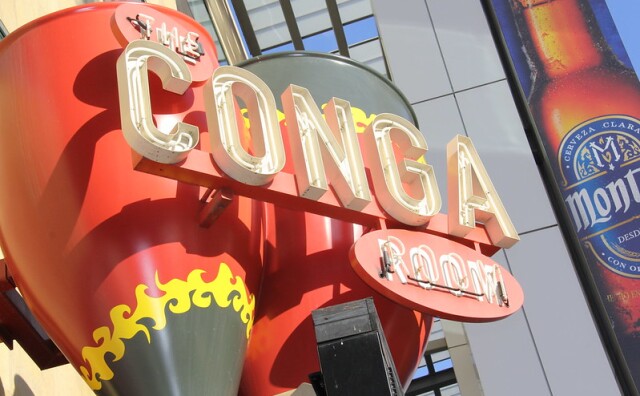Uncovering The History And Impact Of Graffiti Writing In Los Angeles

Graffiti writing as a common form of street art makes a lot of sense in a place like Los Angeles.
Long, frequent commutes make boulevards and freeways the ideal canvas for artists to get eyes on a statement they're trying to make or a conversation they're trying to start.
Like many forms of art, graffiti writing is not without controversy — it is often used in acts of vandalism and has been associated with gang activity because of its use by those groups to mark territory. But graffiti writers will tell you their art form is not only about communicating with each other as artists, it's about starting conversations about things like identity, politics or movements the artist feels aren't being had.
LAist talked with local experts on street art and graffiti writing, as well as graffiti writers and artists themselves, about the earliest iterations of this type of street art in Los Angeles, how it morphed into the graffiti writing we see today and its significance as a form of artistic expression in the Southern California art scene.
'Hobo graffiti' and early examples
Some of the earliest graffiti you'll still find in Los Angeles today dates back to the 1870s, from a Civil War-era building in the neighborhood of Wilmington.
Graffiti from around this era was part of so-called "hobo times" according to Susan Phillips, a professor of environmental analysis at Pitzer College and author of The City Beneath: A Century of Los Angeles Graffiti.

"As the country transferred from an agrarian society to more of an industrialized society post-Civil War, you just get massive numbers of people who are displaced and travel all over the country," said Phillips. "And then [they] eventually create these incredible written traditions with their own history."
-
Mogul acknowledges assault on ex-girlfriend Cassie
-
First crewed launch is delayed again
-
Mickey and the rest of the gang vote to unionize
So for the decades following, you'd see the "hobo graffiti" era take shape in these small-scale hieroglyphs made for writers as a means of communicating with one another.
L.A. graffiti writing as a form of protest
As graffiti writing evolved over the years, it also became a way for artists to tell a political message, or call attention to an issue they feel isn't being represented in other forms of media.
"The wall is almost both a first and last resort for telling an alternative story and history ... and it's meant to get people maybe a bit angry, maybe a bit annoyed," said Stefano Bloch, professor of cultural geography at the University of Arizona and the author of Going All City: Struggle And Survival in LA’s Graffiti Subculture.
"It's meant to bring information to people who have a different form of literacy. So, wall art or murals or graffiti or whatever you want to call it ... gets people riled and it does that on purpose," said Bloch, who was himself a noted graffiti writer who went by the name "Cisco" in Los Angeles in the 1990s.
One of the most notable political murals still around today can be found on Olvera Street — Mexican muralist David Alfaro Siqueiros's América Tropical: Oprimida y Destrozada por los Imperialismos, one of three pieces done in the artist's time in political exile in Los Angeles.
América Tropical and his other public project, Street Meeting, were seen as controversial and ultimately whitewashed (literally painted over with white paint), although the former was found to still be intact in the 1960s.
Projects like these helped fuel parts of El Movimiento in Los Angeles. One group that is well known for its political art in L.A. was Asco, a collective of Chicano artists whose work includes performance art like Stations of the Cross and graffiti writing like Spray Paint LACMA.
"I do remember is their uses of public space, photography, and street theater in a sense ... pushing the boundaries of all that [and] was a great celebratory moment [for] the Chicano movement," said Phillips.
But even within the Chicano movement, graffiti artists had to fight for recognition. Chaz Bojórquez, who is seen as the "godfather of West Coast graffiti," has noted that some Chicano artists viewed graffiti as anti-Chicano that undermined the larger goal of the movement.
Increase name recognition
Dating back to some of the earliest known graffiti writers in L.A. like Bojórquez, graffiti was a creative outlet that was meant to be a political statement and also a means for artists to get their name out there.

Not every artist who grew up in Los Angeles could get their art seen through traditional means. It's why Professor Bloch considers graffiti writing as a means for "other people [to] see their name and think about them."
"It's meant to bring information to people who have a different form of literacy. So, wall art or murals or graffiti or whatever you want to call it ... gets people riled and it does that on purpose."
"They're doing it in an aesthetically pleasing way sometimes, sometimes they're doing it [cryptically] … but it's always about a conversation with surfaces," Bloch said. "The legality of surfaces, the appropriate placement of surfaces, and subcultural hierarchy."
How graffiti writers are making money
When graffiti writer Man One began his career in 1980s, the first thing he tagged was a bus.
"When I first started, I started talking about transit ... because the bus is what moves us around as kids. I was 16, 17 years old and taking the bus all over the, all over the place."
He has since spun that desire to start conversations into exhibitions across Southern California, the Smithsonian in Washington D.C., the Parco Museum in Japan, and more.
Man One said when he was starting out, magazines were one of the only ways that graffiti writers like him could get exposure, at least beyond people happening upon their work in public.
"The first magazines that I saw were probably coming out of L.A. [like] Can Control Magazine ... but the book Spray Can Art, that came from New York, that was one of our Bibles," Man One said. "Subway Art was another book, but Spray Can Art spoke to the world ... artwork that was being painted on walls [and] not just on subway trains."
Not only did these magazines serve as inspiration, but getting any of your work published could mean getting into an art exhibition and eventually making a living from your work.

Growing through every new piece of graffiti writing, or other artistic projects writers did, is what helped create word-of-mouth that eventually translated to commissions.
"I remember the first time I got paid $50 to paint a garage door. I was like, 'This is it. Someone paid me $50, that means I can make $100, that means I can make $200, and it just snowballed from there," Man One said.
Since then, social media has become more of a platform for folks to find your work. Graffiti writers of all generations across the country have found similar artistic mediums that help grow their portfolios.
"Graffiti writers in the East Coast go into graphic design, tattooing, many different types of artistic endeavors that pay," Bloch said. "Here on the West Coast, a lot of graffiti writers go into the film industry as set designers or set dressers, background dressers, or any kind of artistic endeavor, even into fashion and television writing."
Listen to the conversation
-
A new trend in travel focuses on disconnecting from modern life and reconnecting with oneself in nature. It's called a "quiet vacation."
-
Samy Kamienowicz, the man who founded the retail camera stores and became a fixture for the city's creative community, has died. Los Angeles pays tribute.
-
The music will live on through the nonprofit Conga Kids.
-
Known for its elaborate light displays, this year, the neighborhood is expecting a bigger crowd tied to the release of “Candy Cane Lane” on Amazon Prime Video.
-
Dancers at Star Garden demanded better working conditions — including protection from aggressive guests. Up next: An actual contract.
-
The Alliance of Motion Picture and Television Producers rejected the SAG-AFTRA union's request for a separate type of residual payment that actors would get once their programs hit streaming services.






